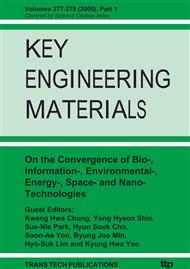p.148
p.155
p.162
p.171
p.177
p.183
p.189
p.193
p.200
Development of High-Performance Ultra-Small Size RF Chip Inductors for Wireless Communication System Application
Abstract:
This work investigates ultra-small size, high-performance, solenoid-type RF chip inductors for wireless communication system application. The materials (96wt% Al2O3) and shape (I-type) of the core, the diameter (40 µm) of the coil, and the length (0.35 mm) of solenoid were determined by a Maxwell three-dimensional (3D) field simulator to maximize the performance of the inductors. The dimensions of the RF chip inductors fabricated were 1.0 mm×0.5 mm×0.5 mm and copper (Cu) coils were used. The high-frequency characteristics of the inductance (L) and quality factor (Q) of the developed inductors were measured using a RF impedance/material analyzer (E4991A with an E16197A test fixture). The developed inductors with 6 coil turns exhibit an inductance of 11 to 11.3 nH, have a quality factor of 22.3 to 65.7 over the frequency ranges of 250 MHz to 1.7 GHz, and show results comparable to those measured for the inductors prepared recently by CoilcraftTm. The simulated data predicted the high-frequency data of the L and Q of the inductors developed well. It was suggested from the equivalent circuit model of the developed inductors that the developed inductors with 6 turns have a self-resonant frequency of 8 GHz.
Info:
Periodical:
Pages:
177-182
Citation:
Online since:
January 2005
Authors:
Price:
Сopyright:
© 2005 Trans Tech Publications Ltd. All Rights Reserved
Share:
Citation:


